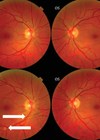Posterior globe flattening has been well-documented in astronauts both during and after long-duration spaceflight (LDSF). This globe flattening is thought to be due to the disc centred anterior forces created by elevated volume and / or pressure within the optic nerve sheath. In 2011, a report from the United States National Aeronautical and Space Administration (NASA) documented neurological findings in seven astronauts after LDSF. The aim of this paper was to report the long-term follow-up and persistence of globe flattening, for seven years or more following LDSF in these astronauts. The authors report posterior global flattening in three astronauts that has persisted for seven years or more following their return from LDSF, suggesting that permanent scleral remodelling may have occurred. The implications of this are that future astronauts should anticipate and be warned about potential for optically correctable, long-term visual changes of unpredictable magnitude, during and after LDSF.




